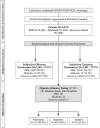Epidemiological, otolaryngological, olfactory and gustatory outcomes according to the severity of COVID-19: a study of 2579 patients
- PMID: 33452919
- PMCID: PMC7811338
- DOI: 10.1007/s00405-020-06548-w
Epidemiological, otolaryngological, olfactory and gustatory outcomes according to the severity of COVID-19: a study of 2579 patients
Erratum in
-
Correction to: Epidemiological, otolaryngological, olfactory and gustatory outcomes according to the severity of COVID-19: a study of 2579 patients.Eur Arch Otorhinolaryngol. 2021 Aug;278(8):2861. doi: 10.1007/s00405-021-06656-1. Eur Arch Otorhinolaryngol. 2021. PMID: 33564911 Free PMC article. No abstract available.
Abstract
Objective: To investigate prevalence and epidemiological and clinical factors associated with olfactory dysfunction (OD) and gustatory dysfunction (GD) in COVID-19 patients according to the disease severity.
Study design: Cross-sectional study.
Methods: A total of 2579 patients with a positive diagnosis of COVID-19 were identified between March 22 and June 3, 2020 from 18 European hospitals. Epidemiological and clinical data were extracted. Otolaryngological symptoms, including OD and GD, were collected through patient-reported outcome questionnaire and Sniffin'Sticks tests were carried out in a subset of patients.
Results: A total of 2579 patients were included, including 2166 mild (84.0%), 144 moderate (5.6%) and 269 severe-to-critical (10.4%) patients. Mild patients presented an otolaryngological picture of the disease with OD, GD, nasal obstruction, rhinorrhea and sore throat as the most prevalent symptoms. The prevalence of subjective OD and GD was 73.7 and 46.8%, and decreases with the severity of the disease. Females had higher prevalence of subjective OD and GD compared with males. Diabetes was associated with a higher risk to develop GD. Among the subset of patients who benefited from psychophysical olfactory evaluations, there were 75 anosmic, 43 hyposmic and 113 normosmic patients. The prevalence of anosmia significantly decreased with the severity of the disease. Anosmia or hyposmia were not associated with any nasal disorder, according to SNOT-22.
Conclusion: OD and GD are more prevalent in patients with mild COVID-19 compared with individuals with moderate, severe or critical diseases. Females might have a higher risk of developing OD and GD compared with males.
Keywords: Anosmia; COVID-19; Clinical; Coronavirus; Epidemiological; Hyposmia; Olfactory; Outcome; SARS-CoV-2; Smell.
Conflict of interest statement
The authors declare that they have no conflict of interest.
Figures



Similar articles
-
Olfactory and gustatory dysfunctions as a clinical presentation of mild-to-moderate forms of the coronavirus disease (COVID-19): a multicenter European study.Eur Arch Otorhinolaryngol. 2020 Aug;277(8):2251-2261. doi: 10.1007/s00405-020-05965-1. Epub 2020 Apr 6. Eur Arch Otorhinolaryngol. 2020. PMID: 32253535 Free PMC article.
-
Objective gustatory and olfactory dysfunction in COVID-19 patients: a prospective cross-sectional study.Eur Arch Otorhinolaryngol. 2021 Sep;278(9):3325-3332. doi: 10.1007/s00405-020-06590-8. Epub 2021 Jan 20. Eur Arch Otorhinolaryngol. 2021. PMID: 33471170 Free PMC article.
-
Olfactory Dysfunction and Sinonasal Symptomatology in COVID-19: Prevalence, Severity, Timing, and Associated Characteristics.Otolaryngol Head Neck Surg. 2020 Jul;163(1):114-120. doi: 10.1177/0194599820929185. Epub 2020 May 19. Otolaryngol Head Neck Surg. 2020. PMID: 32423357 Free PMC article.
-
Long-term Consequences of COVID-19: Chemosensory Disorders.Curr Allergy Asthma Rep. 2023 Feb;23(2):111-119. doi: 10.1007/s11882-022-01062-x. Epub 2022 Dec 27. Curr Allergy Asthma Rep. 2023. PMID: 36574210 Free PMC article. Review.
-
Olfactory Dysfunction: A Highly Prevalent Symptom of COVID-19 With Public Health Significance.Otolaryngol Head Neck Surg. 2020 Jul;163(1):12-15. doi: 10.1177/0194599820926464. Epub 2020 May 5. Otolaryngol Head Neck Surg. 2020. PMID: 32366160 Review.
Cited by
-
Prevalence of and risk factors for depression, anxiety, and stress in non-hospitalized asymptomatic and mild COVID-19 patients in East Java province, Indonesia.PLoS One. 2022 Jul 7;17(7):e0270966. doi: 10.1371/journal.pone.0270966. eCollection 2022. PLoS One. 2022. PMID: 35797394 Free PMC article.
-
The Effects of Persistent Olfactory and Gustatory Dysfunctions on Quality of Life in Long-COVID-19 Patients.Life (Basel). 2022 Jan 19;12(2):141. doi: 10.3390/life12020141. Life (Basel). 2022. PMID: 35207429 Free PMC article.
-
Patterns of COVID-19-related headache: A cross-sectional study.Clin Neurol Neurosurg. 2022 Aug;219:107339. doi: 10.1016/j.clineuro.2022.107339. Epub 2022 Jun 14. Clin Neurol Neurosurg. 2022. PMID: 35753162 Free PMC article.
-
Post-acute COVID-19 syndrome.Eur Respir Rev. 2022 Mar 9;31(163):210185. doi: 10.1183/16000617.0185-2021. Print 2022 Mar 31. Eur Respir Rev. 2022. PMID: 35264409 Free PMC article. Review.
-
Six-month smell and taste recovery rates in coronavirus disease 2019 patients: a prospective psychophysical study.J Laryngol Otol. 2021 May;135(5):436-441. doi: 10.1017/S002221512100116X. Epub 2021 Apr 23. J Laryngol Otol. 2021. PMID: 33888166 Free PMC article.
References
-
- WHO website. www.who.int/docs Consulted July 24, 2020.
MeSH terms
Grants and funding
LinkOut - more resources
Full Text Sources
Other Literature Sources
Medical
Miscellaneous

